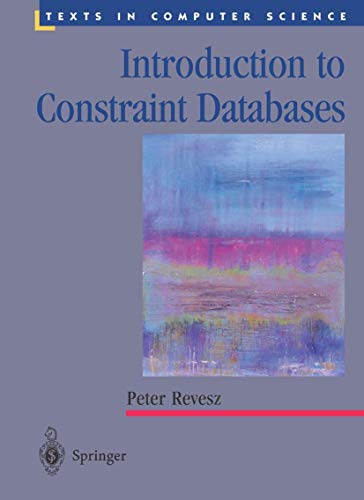constraint databases (163 Ergebnisse)
Suchfilter
Produktart
- Alle Product Types
- Bücher (163)
- Magazine & Zeitschriften (Keine weiteren Ergebnisse entsprechen dieser Verfeinerung)
- Comics (Keine weiteren Ergebnisse entsprechen dieser Verfeinerung)
- Noten (Keine weiteren Ergebnisse entsprechen dieser Verfeinerung)
- Kunst, Grafik & Poster (Keine weiteren Ergebnisse entsprechen dieser Verfeinerung)
- Fotografien (Keine weiteren Ergebnisse entsprechen dieser Verfeinerung)
- Karten (Keine weiteren Ergebnisse entsprechen dieser Verfeinerung)
- Manuskripte & Papierantiquitäten (Keine weiteren Ergebnisse entsprechen dieser Verfeinerung)
Zustand Mehr dazu
- Neu (138)
- Wie Neu, Sehr Gut oder Gut Bis Sehr Gut (12)
- Gut oder Befriedigend (12)
- Ausreichend oder Schlecht (Keine weiteren Ergebnisse entsprechen dieser Verfeinerung)
- Wie beschrieben (1)
Weitere Eigenschaften
- Erstausgabe (1)
- Signiert (Keine weiteren Ergebnisse entsprechen dieser Verfeinerung)
- Schutzumschlag (Keine weiteren Ergebnisse entsprechen dieser Verfeinerung)
- Angebotsfoto (57)
- Keine Print-on-Demand Angebote (124)
Sprache (1)
Gratisversand
Land des Verkäufers
Verkäuferbewertung
-
Introduction to Constraint Databases (Texts in Computer Science)
Buch 9 von 83: Texts in Computer ScienceAnbieter: Bay State Book Company, North Smithfield, RI, USA
Zustand: very_good.
-
Hardcover. Zustand: Good. Connecting readers with great books since 1972! Used textbooks may not include companion materials such as access codes, etc. May have some wear or writing/highlighting. We ship orders daily and Customer Service is our top priority!
-
Introduction to Constraint Databases (Texts in Computer Science)
Buch 9 von 83: Texts in Computer ScienceAnbieter: Lucky's Textbooks, Dallas, TX, USA
EUR 52,49
EUR 3,39 shipping
Versand innerhalb von USAAnzahl: Mehr als 20 verfügbar
In den WarenkorbZustand: New.
-
Inductive Databases and Constraint-Based Data Mining.
Anbieter: Universitätsbuchhandlung Herta Hold GmbH, Berlin, Deutschland
XVII, 456 p. Hardcover. Versand aus Deutschland / We dispatch from Germany via Air Mail. Einband bestoßen, daher Mängelexemplar gestempelt, sonst sehr guter Zustand. Imperfect copy due to slightly bumped cover, apart from this in very good condition. Stamped. Stamped. Sprache: Englisch.
-
Zustand: Brand New. New. US edition. Expediting shipping for all USA and Europe orders excluding PO Box. Excellent Customer Service.
-
Zustand: New. This is a Brand-new US Edition. This Item may be shipped from US or any other country as we have multiple locations worldwide.
-
Zustand: New. Brand New Original US Edition. Customer service! Satisfaction Guaranteed.
-
Brand new book. Fast ship. Please provide full street address as we are not able to ship to P O box address.
-
Constraint-Based Mining and Inductive Databases
Anbieter: Majestic Books, Hounslow, Vereinigtes Königreich
EUR 29,56
EUR 7,46 shipping
Versand von Vereinigtes Königreich nach USAAnzahl: 1 verfügbar
In den WarenkorbZustand: New. pp. 420 Illus.
-
Zustand: New. pp. 420.
-
Constraint Databases: First International Symposium, CDB 2004, Paris, France, June 12-13, 2004, Proceedings
Sprache: Englisch
Verlag: Springer Verlag, New York City, 2004
ISBN 10: 3540221263 ISBN 13: 9783540221265
Anbieter: Doss-Haus Books, Redondo Beach, CA, USA
Hardcover. Zustand: Very Good. No Jacket. Hardcover 2004 library bound edition. Ex-library book with stamps and labels attached. Binding firm. Pages unmarked and clean. Laminated covers and text in very good to near fine condition. Series: Lecture Notes in Computer Science ;3074. [xii, 180 p. : ill. ; 24 cm].
-
Constraint Databases
Anbieter: books4less (Versandantiquariat Petra Gros GmbH & Co. KG), Welling, Deutschland
gebundene Ausgabe. Zustand: Gut. 428 Seiten Der Erhaltungszustand des hier angebotenen Werks ist trotz seiner Bibliotheksnutzung sehr sauber. Es befindet sich lediglich ein Bibliotheksstempel im Buch; ordnungsgemäß entwidmet. Sprache: Englisch Gewicht in Gramm: 680.
-
Constraint-Based Mining and Inductive Databases
Anbieter: Biblios, Frankfurt am main, HESSE, Deutschland
Zustand: New. pp. 420.
-
Introduction To Constraint Databases
Buch 9 von 83: Texts in Computer ScienceAnbieter: Basi6 International, Irving, TX, USA
Zustand: Brand New. New. US edition. Expediting shipping for all USA and Europe orders excluding PO Box. Excellent Customer Service.
-
Introduction To Constraint Databases
Buch 9 von 83: Texts in Computer ScienceAnbieter: Romtrade Corp., STERLING HEIGHTS, MI, USA
Zustand: New. This is a Brand-new US Edition. This Item may be shipped from US or any other country as we have multiple locations worldwide.
-
Paperback. Zustand: Very Good. Ex-library paperback in very nice condition with the usual markings and attachments.
-
Paperback. Zustand: Very Good. Ex-library paperback in very nice condition with the usual markings and attachments. Text block clean and unmarked. Tight binding.
-
Introduction to Constraint Databases (Texts in Computer Science)
Buch 9 von 83: Texts in Computer ScienceAnbieter: ALLBOOKS1, Direk, SA, Australien
Brand new book. Fast ship. Please provide full street address as we are not able to ship to P O box address.
-
Constraint-Based Mining and Inductive Databases : European Workshop on Inductive Databases And Constraint Based Mining, Hinterzarten, Germany, March 11-13, 2004, Revised Selected Papers
Anbieter: GreatBookPrices, Columbia, MD, USA
EUR 52,89
EUR 2,24 shipping
Versand innerhalb von USAAnzahl: Mehr als 20 verfügbar
In den WarenkorbZustand: New.
-
Zustand: Brand New. New. US edition. Expediting shipping for all USA and Europe orders excluding PO Box. Excellent Customer Service.
-
Constraint Databases : First International Symposium, CDB 2004, Paris, France, June 12-13, 2004, Proceedings
Anbieter: GreatBookPrices, Columbia, MD, USA
EUR 52,94
EUR 2,24 shipping
Versand innerhalb von USAAnzahl: Mehr als 20 verfügbar
In den WarenkorbZustand: New.
-
Constraint Databases and Applications: First International Symposium, CDB 2004, Paris, France, June 12-13, 2004, Proceedings (Lecture Notes in Computer Science, 3074)
Anbieter: Lucky's Textbooks, Dallas, TX, USA
EUR 51,76
EUR 3,39 shipping
Versand innerhalb von USAAnzahl: Mehr als 20 verfügbar
In den WarenkorbZustand: New.
-
Constraint Databases and Applications: Second International Workshop on Constraint Database Systems, CDB '97, Delphi, Greece, January 11-12, 1997, ... (Lecture Notes in Computer Science, 1191)
Anbieter: Lucky's Textbooks, Dallas, TX, USA
EUR 52,09
EUR 3,39 shipping
Versand innerhalb von USAAnzahl: Mehr als 20 verfügbar
In den WarenkorbZustand: New.
-
Constraint-Based Mining and Inductive Databases: European Workshop on Inductive Databases and Constraint Based Mining, Hinterzarten, Germany, March ... (Lecture Notes in Computer Science, 3848)
Anbieter: Lucky's Textbooks, Dallas, TX, USA
EUR 52,49
EUR 3,39 shipping
Versand innerhalb von USAAnzahl: Mehr als 20 verfügbar
In den WarenkorbZustand: New.
-
Zustand: Good. 345 pp., Paperback, ex library, else text clean and binding tight. - If you are reading this, this item is actually (physically) in our stock and ready for shipment once ordered. We are not bookjackers. Buyer is responsible for any additional duties, taxes, or fees required by recipient's country.
-
Introduction to Constraint Databases (Texts in Computer Science)
Buch 9 von 83: Texts in Computer ScienceAnbieter: Lucky's Textbooks, Dallas, TX, USA
EUR 52,75
EUR 3,39 shipping
Versand innerhalb von USAAnzahl: Mehr als 20 verfügbar
In den WarenkorbZustand: New.
-
Introduction to Constraint Databases
Buch 9 von 83: Texts in Computer ScienceAnbieter: Books Puddle, New York, NY, USA
Zustand: New. pp. 412.
-
Brand new book. Fast ship. Please provide full street address as we are not able to ship to P O box address.
-
Constraint Databases : First International Symposium, CDB 2004, Paris, France, June 12-13, 2004, Proceedings
Anbieter: GreatBookPrices, Columbia, MD, USA
EUR 60,27
EUR 2,24 shipping
Versand innerhalb von USAAnzahl: Mehr als 20 verfügbar
In den WarenkorbZustand: As New. Unread book in perfect condition.














